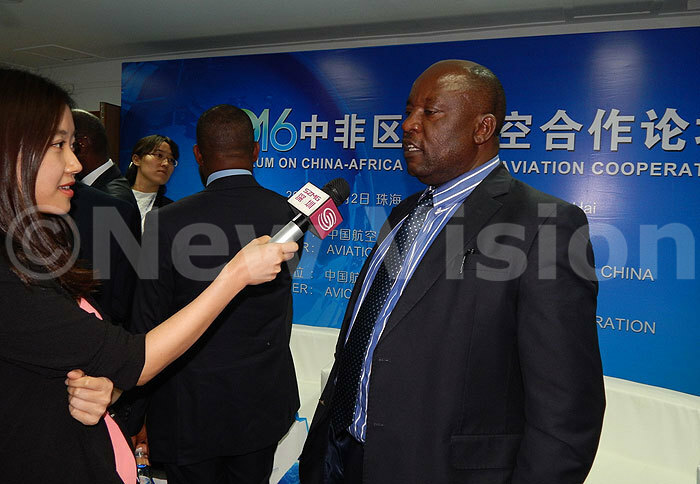China to boost aviation sector in Africa
China has so far signed aviation cooperation agreements with 12 African countries.
China plans to train at least 500 aviation personnel from Africa annually as part of efforts to boost the continent's fast-growing aviation sector.
Shu Limei, the commercial councilor for Asia and Africa in Guangdong Province made the pledge at the China-Africa Aviation Forum held in China's Zhuhai City.
"We will help Africa to deal with challenges such as backward infrastructure and low financing. Aviation is one of the areas of cooperation in infrastructure between Africa and China," she said.
Passenger travels between Africa and China have risen in recent years, reaching 73.8m people 2014, up from 14 million in 2004.
Apart from supporting Africa to deal with structural issues, China is also looking at Africa as a thriving market for her new aircraft to replace ageing fleet operated by most airlines.
China has so far signed aviation cooperation agreements with 12 African countries and air worthiness contracts with nine African states, paving way for more partnerships in the sector.
Against the tide of growing bilateral relations, Chinese commercial airlines have opened four direct routes from China to Ethiopia, South Africa, Kenya and Mauritius.
In 2005, the Republic of Congo purchased three MA60 civil aircraft from China, becoming the first African country to fully operate the China-manufactured civil aircraft.
The aircraft have operated for ten years, exceeding 6,000 flight hours and 200,000 passengers, according to aviation records.

Eng. Fred Kyankya, the general manager of Uganda Air Cargo Cooperation speaks to a reporter at the China-Africa Aviation Forum in Zhuhai, China. (Credit: Taddeo Bwambale)
In November 2012, Cameroon purchased one MA60 aircraft and it has since clocked over 1700 flight hours, 1200 takeoff and landings with at least 60,000 passengers hauled.
In 2015, the West African country purchased two more aircraft for its national airline that now ply the Yaounde-Douala route.
Since then, a total of 14 MA60s aircraft manufactured by Aviation Industry Corporation of China (AVIC) have been delivered to eight African countries.
An additional 37 Y12s aircraft are in use by seven African countries and several countries in South America and South Pacific regions.
Several African countries have also signed sales contracts or memoranda of understanding with AVIC for the purchase of the ARJ21 aircraft.
In 2014, AVIC established a technical support center in Tanzania to handle repairs and produce accessories facility for the ARJ21.
A similar facility is being set up in Congo for the repair of the MA60, ARJ21 and Y12 and it is expected to be ready by the end of 2018.
Ageing aircraft
Eng Fred Kyankya, the general manager of the Uganda Air Cargo Corporation said low investment in the aviation sector in Africa has created huge operational challenges.
"We largely operate old equipment that is retired from markets in Europe, Middle East and Asia, which explains the declining safety record," he said at an aviation forum in Zhuhai, China.

Shu Limei, the provincial councillor for commerce in charge of Asia and Africa. (Credit: Taddeo Bwambale)
In 2011, the average number of air traffic accidents was nine times higher than the global average, Kyankya said, attributing the problem to non-enforcement of standards and practices."
Presenting a paper on the ‘State of Aviation in Africa,' Kyankya observed that although Africa is the second largest continent, its share of the global aviation market remains very dismal.
In 2013, airlines in Africa carried about 70 million passengers out of 3.1 billion passengers globally and transported 50 million tons of cargo, just 2% of the total global volumes.
Africa's aviation market supported about 6.7 million jobs, out of the global figure of 57 million globally and the sector generated $67.8bn (12%) of the global revenue of $540b.
According to Kyankya, while the global net profit margin for the industry was 2.6% between 2010 and 2015, African airlines were making losses.
Growing sector
In spite of the challenges, Kyankya said the demand for air transport in Africa was rising, partly due to new economic opportunities such as the discovery of oil and several mineral resources.
Quoting recent figures, he said passenger traffic in Africa was estimated to grow at 6.1%, above the global target of 5.8% but behind the Middle East (7.9%) and Asia Pacific (6.9%).
He explained that the projected growth trend is also linked to economic growth, political stability, a demographic boom, increasing urbanization and rise of a middle class in Africa.
In order to boost the sector, Kyankya advised African states ratify the Cape Town Convention, increase the pool of aviation experts, reduce high airport taxes and fees and review regulation.
The China-Africa Aviation Forum brought together global experts to discuss trends in the aviation and ways to boost cooperation.